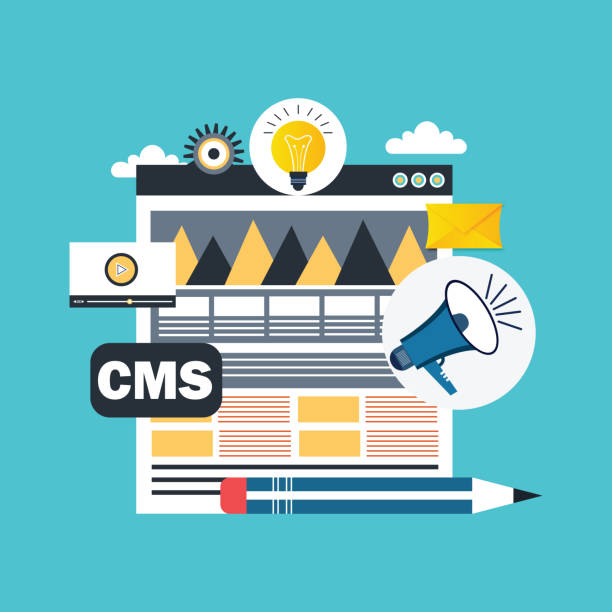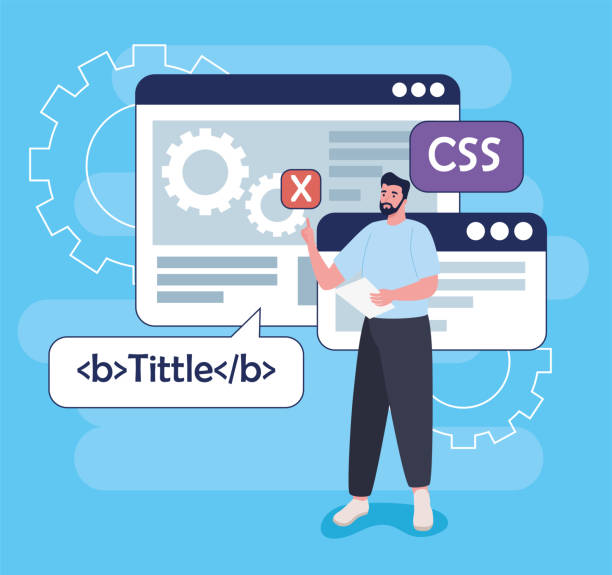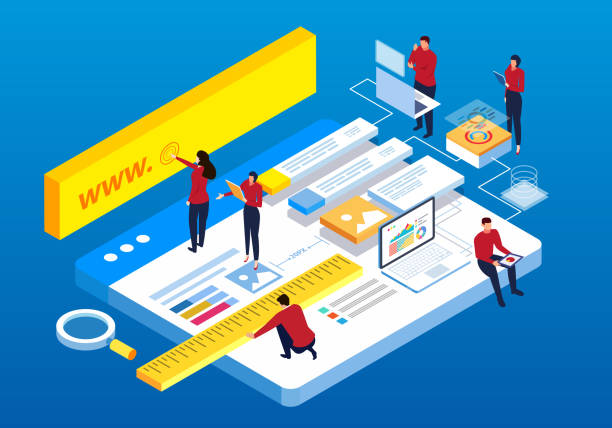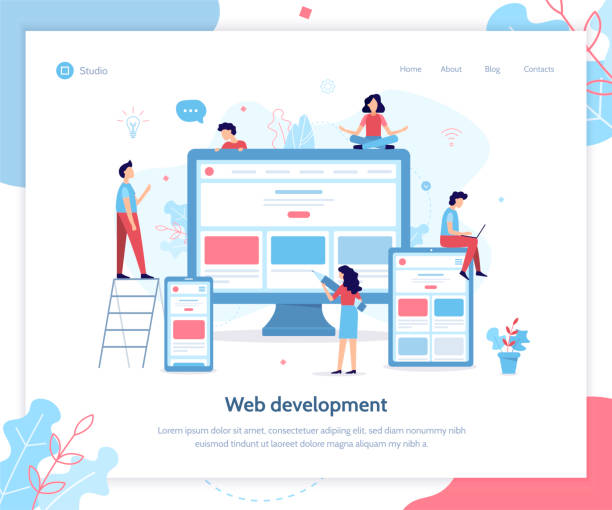The Importance of Speed in Modern Web Design

In today’s digital world where speed is paramount, fast website design is not just an advantage, but an undeniable necessity.
Users expect websites to load immediately, and even the slightest delay can mean losing visitors and customers.
It’s a clear truth that every second of page loading delay can significantly reduce conversion rates.
Research has shown that most users leave a page after waiting a few seconds.
Therefore, the approach of fast website design must be at the core of every web development project.
This not only contributes to user experience (UX) but is also crucial for SEO.
Search engines like Google consider page loading speed as an important factor in website rankings.
Slower websites will rank lower and be less visible.
This is an #explanatory and #news topic that demonstrates why focusing on website performance optimization from the outset is extremely important.
For a business, having a fast-loading website means increased traffic, reduced bounce rate, and ultimately, growth in sales and revenue.
This creates significant added value, especially in current competitive markets, and registers your brand in users’ minds as an efficient and modern service provider.
Do you have an online store, but your sales aren’t as expected? Rasawb solves your problem permanently with professional e-commerce website design!
✅ Significant increase in conversion rate and sales
✅ Unparalleled user experience for your customers
⚡ Click to receive free consultation from Rasawb!
Key Principles for Achieving Fast Website Design

Achieving fast website design requires adhering to a set of principles and best practices.
The first step on this path is choosing suitable and high-speed hosting.
Poor hosting, even with optimized code, can severely slow down your website.
The second important principle is image optimization.
High-volume images are among the most common causes of slow websites.
Using next-generation image formats like WebP and proper image compression without compromising quality significantly improves speed.
Lazy Loading of images and videos also means that content is only loaded when the user scrolls to that section of the page, which significantly reduces initial page load time.
Using Content Delivery Networks (CDNs) is another effective solution.
By caching your website’s content on various servers worldwide, CDN allows users to receive content from the closest server, which dramatically increases loading speed.
This is an educational and guidance topic that helps developers and business owners have high-performance websites.
By implementing these principles, fast website design can be achieved sustainably.
The Role of Hosting and Caching in Increasing Website Speed

As previously mentioned, choosing suitable hosting is the cornerstone of fast website design.
High-quality hosting, especially services like VPS or dedicated servers, provides sufficient bandwidth and resources for your website, preventing loading delays.
Alongside hosting, the concept of Caching is of paramount importance.
Caching means storing a copy of website content (such as HTML, CSS, JavaScript files, and images) in the user’s browser or on the server for faster access on subsequent visits.
When a user visits your website for the second time, instead of reloading all content from the main server, many files are retrieved from the cache, which significantly reduces loading time.
There are different types of caching: browser cache, server cache (like W3 Total Cache in WordPress), and CDN cache.
Combining these methods can significantly improve your website’s performance and provide a better user experience.
This is a specialized and analytical topic that demonstrates how to achieve fast website design through proper resource management and the use of smart technologies.
Below is a table comparing different types of hosting and their impact on website speed.
| Hosting Type | Key Features | Impact on Speed | Suitable For |
|---|---|---|---|
| Shared Hosting | Low-cost, shared resources | Variable, usually slower | Small, personal websites |
| VPS (Virtual Private Server) | Dedicated resources, scalability | Good, improvable | Small and medium businesses |
| Dedicated Hosting | Fully dedicated resources, full control | Excellent, highest speed | Large, high-traffic websites |
| Cloud Hosting | Infinite scalability, distributed | Very good, very stable | Growing businesses, web applications |
Optimizing Code and Resources for Maximum Speed

To achieve a fast website design, merely choosing good hosting is not enough; optimizing code and resources is also crucial.
This process includes minification of CSS, JavaScript, and HTML files.
Minification means removing extra white spaces, comments, and unnecessary characters from the code, which reduces file size and speeds up loading time.
Furthermore, merging CSS and JavaScript files into one or more larger files can reduce the number of HTTP requests to the server, which is an important factor in increasing speed.
Using JavaScript scripts asynchronously or deferring their execution until after the main page content has loaded prevents them from blocking rendering and helps visible content load faster.
This is an analytical and specialized approach that allows developers to pay closer attention to coding details.
Regularly reviewing code to find and remove inefficient code or unnecessary plugins is also of high importance, as every extra line of code can lead to server overhead and reduced speed.
These efforts ultimately lead to a fast and optimized website design that not only improves user experience but also offers significant SEO benefits.
Does your current corporate website present a worthy image of your brand and attract new customers?
If not, transform this challenge into an opportunity with Rasawb’s professional corporate website design services.
✅ Significantly improves your brand’s credibility and image.
✅ Paves the way for attracting new leads and customers for you.
⚡ For a free and specialized consultation, contact Rasawb now!
The Impact of Responsive Design and User Experience on Speed

In the Mobile-first era, fast website design must be accompanied by Responsive Design.
A responsive website means that your website automatically adapts to the screen size of the user’s device, whether it’s a desktop, tablet, or smartphone.
This adaptation not only improves user experience but can also affect loading speed.
Non-responsive design often leads to loading large amounts of unnecessary data for smaller devices, which reduces speed.
Furthermore, the design of the user interface (UI) and user experience (UX) also plays a significant role in how users perceive website speed.
Even if your website is technically fast, a poor UI or complex navigation can make the user feel that the website is slow.
Using lightweight animations, smooth transitions, and quick visual feedback for user actions can enhance this sense of speed.
This is an engaging and yet explanatory topic that shows how design psychology and implementation techniques simultaneously influence the perception of website speed and performance.
Ultimately, focusing on these aspects leads to a fast and pleasant website design for users.
Speed Measurement Tools and Performance Analysis

To ensure that your efforts towards fast website design have been fruitful, you need reliable tools for measuring and analyzing performance.
Google PageSpeed Insights is one of the most popular and free tools that checks loading speed on both desktop and mobile and provides suggestions for improvement.
This tool scores your website based on Core Web Vitals such as Largest Contentful Paint (LCP), Cumulative Layout Shift (CLS), and First Input Delay (FID).
GTmetrix is another tool that displays more details about website performance, including full load time, number of requests, and resource loading sequence, and offers optimization suggestions.
Pingdom Tools is also an excellent option for checking load times and identifying slow resources.
Regular use of these tools allows you to identify your website’s weaknesses and observe the improvements resulting from optimizations.
This is a guidance and specialized section that helps developers and website managers make more informed decisions for speed improvement with accurate data.
Continuous monitoring of website performance is an indispensable part of the fast website design cycle and its maintenance over time.
The Role of CDN in Content Distribution and Speed Increase

Using a Content Delivery Network (CDN) is a powerful strategy for increasing website loading speed, especially for websites with a global audience.
A CDN is a collection of servers dispersed across different geographical locations worldwide.
The primary function of a CDN is to cache (temporarily store) your website’s static content (such as images, CSS, and JavaScript files) and deliver it to users from the closest possible server.
This significantly reduces latency and delivers content to the user at a much higher speed.
Suppose your website’s main server is in Iran, but a user from the US wants to access it.
Without a CDN, the user’s request would have to travel to the server in Iran and the content return.
With a CDN, the cached content is sent to the user from a server near the US (e.g., in New York).
This not only contributes to fast website design but also reduces the load on your main server and increases website stability in the face of high traffic.
Choosing a suitable CDN (such as Cloudflare, Akamai, or Amazon CloudFront) can have a dramatic impact on your website’s overall performance.
This is a specialized and analytical topic that shows how network architecture can directly influence the end-user experience.
Below is a table illustrating Core Web Vitals and their relationship with website speed.
| Metric | Description | Impact on Speed and User Experience | Good Threshold |
|---|---|---|---|
| LCP (Largest Contentful Paint) | Time to render the largest content element in the viewport | User’s perception of main content load speed | Less than 2.5 seconds |
| FID (First Input Delay) | Delay between first user interaction and browser response | Website responsiveness to user interactions | Less than 100 milliseconds |
| CLS (Cumulative Layout Shift) | Amount of unexpected visual layout shifts on the page | Visual stability of the page and prevention of unpleasant experiences | Less than 0.1 |
| FCP (First Contentful Paint) | Time to render the first content (text, image) | Indicates the start of page content loading | Less than 1.8 seconds |
Utilizing New Formats and Smart Compression

One of the most important steps on the path to fast website design is content optimization and compression.
Images and videos, in particular, can constitute a huge volume of data that directly impacts loading time.
Using next-generation image formats like WebP, developed by Google, can reduce file sizes by 25-35% compared to JPEG or PNG, without a noticeable loss in quality.
Additionally, using server-side compression tools like Gzip or Brotli for CSS, JavaScript, and HTML files can reduce their size by up to 80%.
This compression occurs before the file is sent to the user’s browser, drastically reducing data transfer time.
This is an educational and guidance topic that demonstrates how, by choosing the right formats and utilizing compression technologies, website speed can be significantly increased.
Regarding videos, using external services like YouTube or Vimeo and embedding their codes on the website is better than direct video hosting, as these services are designed for optimal and fast video playback.
These comprehensive measures significantly contribute to ensuring a fast and efficient website design.
Are you dissatisfied with the low conversion rate of visitors to customers on your e-commerce site?
Solve this problem permanently with professional e-commerce website design by Rasawb!
✅ Increase visitor-to-customer conversion rate
✅ Create an excellent user experience and build customer trust
⚡ Get free consultation
Optimized Plugins and Themes for Speed

In Content Management Systems ecosystems like WordPress, the choice of plugins and themes plays a very important role in fast website design.
An unsuitable and heavy plugin or theme can negate all your efforts to optimize speed.
Some themes come with excessive features and unnecessary code, which significantly increase loading time.
Therefore, it is recommended to use lightweight and speed-optimized themes that have clean coding and avoid unnecessary functionalities.
Regarding plugins, every new plugin you install means adding new code and more HTTP requests to your website.
Therefore, you should be careful in choosing plugins and only install those you genuinely need.
Caching plugins (such as WP Rocket or LiteSpeed Cache) and image optimization plugins (such as Smush or Imagify) are among the essential tools that directly contribute to speed improvement.
Before installing any plugin, it is advisable to check user reviews and its impact on speed.
This is a thought-provoking content and specialized topic that helps website owners prevent their websites from slowing down through smart choices.
Ultimately, a minimalist approach to using plugins and themes is an important part of the fast website design strategy.
The Future of Fast Website Design and Emerging Trends

The future of fast website design is intertwined with emerging trends and advanced technologies.
Artificial Intelligence (AI) and Machine Learning (ML) are playing an increasing role in automatic website optimization, from identifying the best compression methods to predicting user behavior for proactive content loading.
New JavaScript frameworks like Next.js and Nuxt.js, with Server-Side Rendering (SSR) and Static Site Generation (SSG) capabilities, enable developers to build websites that are fast and optimized by default.
Additionally, WebAssembly, as a new technology, allows for the execution of high-performance code in the browser, which can run web games and complex applications at incredible speeds.
Further development of web standards like HTTP/3 and Brotli also helps reduce latency and increase data transfer speed.
This is a news and engaging section that provides a vision of the bright future of fast web.
With technological advancements, it is expected that website loading speeds will reach a point where latency becomes almost imperceptible, leading to an outstanding user experience.
Ultimately, these advancements move towards faster and more efficient website design for everyone.
Frequently Asked Questions
| Question | Answer |
|---|---|
| What is fast website design? | The process of building a website that loads quickly and provides a smooth user experience. |
| Why is website speed important? | Improved user experience, reduced bounce rate, increased conversion rate, and better search engine ranking (SEO). |
| What factors affect website speed? | Image size, number of HTTP requests, code optimization (HTML, CSS, JS), hosting speed, and browser cache. |
| How can website speed be improved? | Optimizing images, compressing files, using caching, choosing appropriate hosting, and reducing unnecessary plugins. |
| How do images affect website speed? | High-volume images or inappropriate formats can significantly increase page loading time. |
| What is the role of JavaScript and CSS in website speed? | Unoptimized code, large file sizes, or blocking execution can reduce page rendering speed. |
| How much does hosting affect website speed? | The speed and quality of the hosting server directly impact website responsiveness and initial loading speed. |
| What tools are available to check website speed? | Google PageSpeed Insights, GTmetrix, Pingdom Tools are common tools. |
| What are the benefits of a fast website? | Greater user satisfaction, reduced bounce rate, increased time on site, and improved ranking in Google results (SEO). |
| What are common mistakes that slow down a website? | Using unoptimized images, bulky and unorganized coding, excessive use of plugins, and not utilizing caching. |
And other services of Rasawb Advertising Agency in the field of advertising
- Smart Sales Automation: An effective tool to increase click-through rates by using real data.
- Smart Advertising Campaign: A professional solution for digital branding with a focus on intelligent data analysis.
- Smart Digital Branding: A combination of creativity and technology to increase click-through rates by customizing user experience.
- Smart Customer Journey Map: An innovative platform for improving customer behavior analysis with SEO-driven content strategy.
- Smart SEO: A dedicated service for improving SEO ranking based on intelligent data analysis.
And over a hundred other services in the field of internet advertising, advertising consultation, and organizational solutions
Internet Advertising | Advertising Strategy | Advertorial
Resources
Website Design Tutorial on Aparat
Website Design Guide on HamyarSite
Website Design on IranTaf
Tavangar Website Design Services
? For your business to leap forward in the digital world and reach the peak of success, Rasawb Afarin Digital Marketing Agency is your partner and guide, offering comprehensive services including custom website design, SEO, and content marketing.
📍 Tehran, Mirdamad Street, next to Bank Markazi, Southern Kazeroon Alley, Ramin Alley, No. 6

